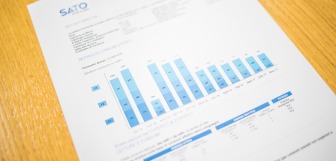How to Make a Cash Flow Statement
Many small business owners dread dealing with the financial side of the business as it can often feel intimidating to work on things like cash flow statements. We walk you through the process of creating a cash flow statement and explain why it matters.
What A Cash Flow Statement Is (and Isn’t)
Simply put, a cash flow statement is a financial document that shows how much cash is coming into the business during a given accounting period and how much cash is flowing out of the business during that same period [1].
“Cash flow” also includes any payments made or received via credit card, ACH, check, etc. [2].
A cash flow statement is not a statement of profit or assets and liabilities [3]. While you may have expenses associated with liability, such as a monthly business loan repayment, the liability itself would not be part of a cash flow statement. Assets and liabilities are included in other types of financial statements.
Activities on Cash Flow Statements
Anything you include on a cash flow statement will fall under one of three main categories [4]:
- Investing activities
- Operating activities
- Financing activities
Investing activities include expenses incurred from purchasing land, buildings, or equipment, also known as capital expenditures [5]. This category could also include purchasing stocks, bonds, etc., on behalf of the business.
Operating activities would include anything involved in the day-to-day operations of your business, from paying your maintenance workers to receiving customer cash payments.
Financing activities could include expenses related to loans, such as loan repayments, paying dividends to shareholders, or issuing and buying back shares in the company.
Why Cash Flow Matters
With everything else you need to keep track of as a small business owner, you may be wondering if tracking and analyzing your cash flow is really all that important, especially if your business is making a profit.
However, you could have great profits, but you don’t have a positive cash flow from those profits [6]. Your immediate expenses may not end up getting paid while you’re waiting for those profits to materialize.
In addition, investors and banks will want to see that you have more cash coming in than going out, so they can feel confident that your business will be stable enough long term for them to risk investing in you [7].
How to Determine Cash Flow
Calculating your cash flow can be complicated. There are two different methods of preparing statements of cash flow [8]:
- Direct cash flow method
- Indirect cash flow method
These two methods are the same when it comes to calculating your cash flow for investing and financing activities and only differ when it comes to operating activities.
Financing Activities
You’ll take the total amount of funds coming in from issuing debt or equity and subtract the total amount of funds paid out as dividends plus repurchases of debt or equity, using the formula below [9]:
Cash flow from financing activities = cash from issuing debt or equity – (dividends paid + debt or equity repurchases)
So, in our example, if you issued $1,000 in debt, paid out $500 in dividends, and spent $250 to repurchase debt, the formula would look like this:
1,000 – (500 + 250)
1,000 – 750
= $250
Your total from financing activities is a positive cash flow of $250.
Investing Activities
The formula for determining cash flows from investing activities is a little more complex than the formula to calculate cash flow from financing activities.
You’ll need to take the total inflows from selling long-term assets, other businesses, and marketable securities and subtract the total outflows from buying long-term assets, purchasing other businesses, and buying marketable securities [10]. The result is your investing activities cash flow.
The formula looks like this:
Cash flow from investing activities = (sale of businesses + sale of securities + sale of long-term assets) – (purchase of securities + purchase of long-term assets + purchase of business)
For example, if you sold a subsidiary for $450,000 and bought a new piece of manufacturing equipment for $350,000 plus you acquired a smaller business for $200,000, then your investing activities cash flow would be:
450,000 – (350,000 + 200,000)
450,000 – 550,000 = -150,000
You would have a negative investing activities cash flow of $150,000. Negative cash flow from investing activities isn’t necessarily bad if the expenditures are going toward long-term improvements and future stability [11].
Operating Activities—Direct Cash Flow Method
The direct cash flow method is best used for small businesses since it requires you to track every receipt and payment made under the operating activities section [12].
You need to include several areas in this method, including all payments received from customers, operating expenses, interest expenses, taxes, and payments to suppliers [13].
The formula looks like this [14]:
Cash flow from operations = cash from customers - (cost of purchases + payments to suppliers + operating costs + interest expenses + tax payments)
Let’s say you had $194,000 in cash from customers. If your cost of purchases were $27,000, payments to suppliers were $16,000, operating costs were $50,000 and taxes and interest were $25,000 for the year, then you’d have:
194,000 – (27,000 + 16,000 + 50,000 + 25,000)
194,000 – 118,000 = $76,000
You’d have a positive operating activities cash flow in the amount of $76,000 in the example above.
Operating Activities—Indirect Cash Flow Method
The indirect cash flow method uses the accrual basis, so it includes accrued revenue, which means customers have placed orders but may not have paid yet [15]. You’ll also include some non-cash expenses and income here, unlike with the direct cash flow method.
Non-cash expenses/income could include things like [16]:
- Amortization
- Accounts receivable losses
- Depreciation
- Gains/losses from selling assets
Counterintuitively, you’ll need to subtract your gains from the net income for the period and add your losses/expenses back to net income.
You’ll also factor in changes to your asset and liability accounts, like:
- Inventory
- Receivables
- Prepaid expenses
- Accounts receivable
- Accounts payable
- Accrued expenses
You’ll subtract the increases and add the decreases for your asset accounts to your net income.
For the liability accounts, you’ll add the increases and subtract the decreases to your net income.
Using the indirect method, you would calculate your operating activities cash flow with the following formula:
Operating activities cash flow = net income – non-cash gains/revenue + non-cash losses/expenses + losses from assets – gains from assets + increases in liabilities – decreases in liabilities
For example, you have $330,000 in net income, $5,000 in depreciation, a $2,000 increase in inventory, a $30,000 increase in accounts payable, and a $15,000 decrease in accrued expenses. That would look like:
330,000 + 5,000 – 2,000 + 30,000 – 15,000
= $348,000
In the scenario above, you have a positive operating activities cash flow of $348,000.
You’ll probably need accounting software, or at the very least, a spreadsheet program to help you prepare a cash flow statement. Believe it or not, your point of sale system can make preparing your cash flow statement even easier.
Cash Flow Statements Made Easier
One key component of a cash flow statement is accurately capturing sales from customers. A good point of sale system will easily track sales for you and should provide easy-to-use reports that track sales over a specific time period, marking off one task on your cash flow statement to-do list.
Epos Now also enables you to quickly track inventory and is, of course, compatible with major credit cards. Not only that, but epos now makes it easy to accept apple pay and google pay purchases.
Knowing that you don’t have to manually track sales or hunt down sales reports from multiple sources can help simplify the process of creating a cash flow statement.




